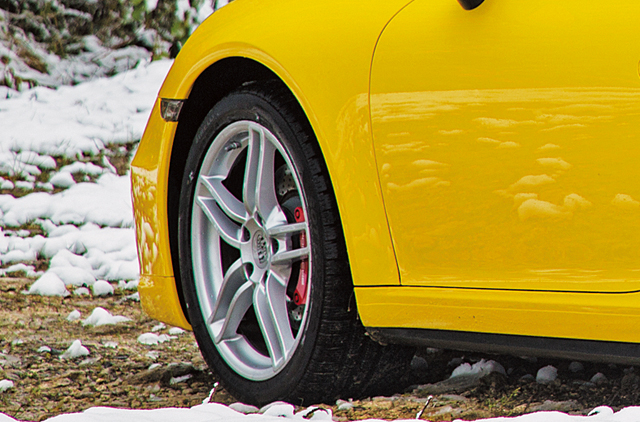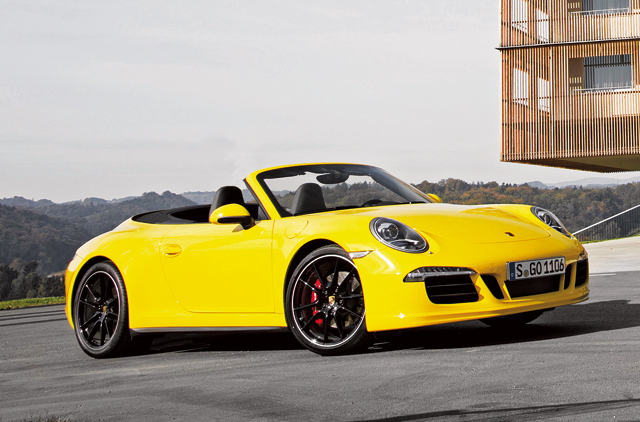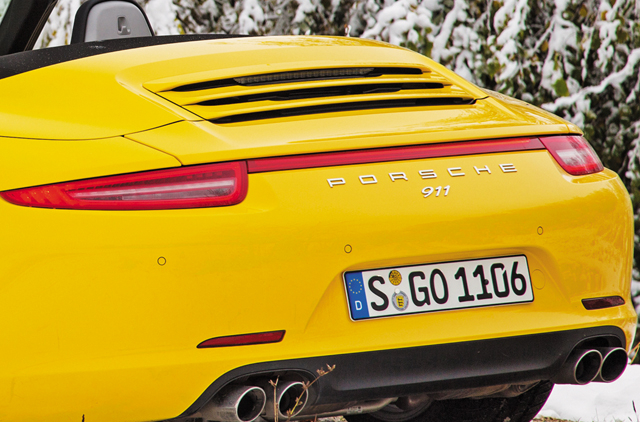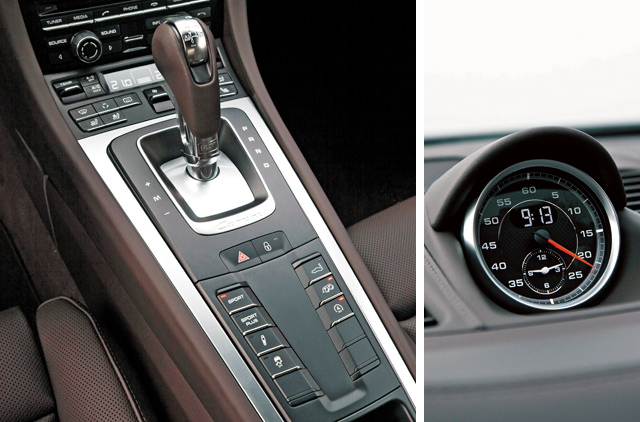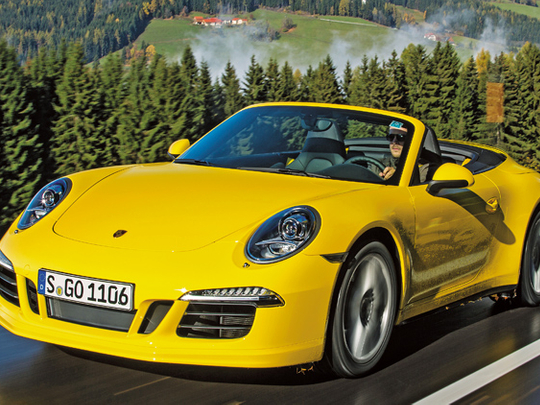
I suppose it could have been coincidence, but given the professional manner in which Porsche runs its test drives, I’m not so sure. Was it really pure chance that 30 minutes after I reached my hotel in Graz, following a two-hour drive on rain-soaked roads, the temperature dropped to freezing and it snowed through the night? I mean, if you’re going to put a powerful four-wheel drive sportscar to the test, what better way than to drive on wet roads on Day One and ice and snow on Day Two?
“It’s unusual for this time of year,” I was informed. “Oh and by the way, tomorrow you’re driving the yellow convertible.” Brrrrrr-illiant. The temptation to drive around with the roof down was more than I could resist, but since my health insurance doesn’t cover frostbite, I drew the line at blast freezing my ears after just 15 minutes.
Still I’m happy to report that during that time, the exhaust note of the 3.8-litre boxer engine in the Carrera 4S sounded great, and if you’ve activated the optional sports exhaust system, it sounds better still. With the insulated, magnesium- framed roof back up, which thankfully only takes 13 teeth-chattering seconds, once normal blood flow has returned to your ear lobes you’ll realise that the Sound Symposer is doing its job and transmitting engine notes into the cabin.
But as with the Cayenne GTS I drove a few months ago, I look upon the Symposer as a sound damper when switched off, not an amplifier when switched on. Each to their own. What I definitely do recommend leaving switched on is the myriad of handling, roll damping, power vectoring and chassis management systems Porsche has designed to keep you on the safe and narrow. Safe and narrow ribbons of zero-friction tarmac that is.
Mountain passes that would have been exhilarating to drive in summer months, took on the treacherous air of bobsleigh runs when coated, as they were, in snow, slush and thick ice. The prospect of tackling them at speed in a 400 horsepower rear-engined car was as invigorating as the chilly Austrian air. ‘Snow Drift’ anyone?
I knew that the PTM, Porsche’s Traction Management, was good, because I’d experienced it in the Cayenne GTS, but that was on dry roads in the summer. PTM monitors the car’s wheel speeds, its transverse (is this car going sideways?) and longitudinal acceleration (or is it going backwards?) and the driver’s steering inputs (is it supposed to be going sideways?).
It then determines whether the car would benefit from a healthy dose of front-wheel drive, and if so, reduces the torque to the rear wheels and sends much of it to the front instead via a multi-clutch plate. Throw in the optional Torque Vectoring Plus system, which varies the torque delivered to the rear wheels and controls a rear differential lock, and you’ve ultimately got no direct physical connection between the driver and the tyres. Which can have its benefits, but as I came to realise, causes one specific problem.
As my Carrera climbed and the temperatures descended, so did the levels of friction beneath my wheels, but as I’d expected, it made hardly a jot of a difference to the speed at which I could fling the 4S into any situation. And as my confidence in the car, or rather, its electronics grew, so did the temptation to put those systems to increasingly challenging tests, until eventually, it was my own instincts for self preservation that limited my speed.
Braking hard down into hairpin turns awash with icy water? Don’t worry about it. Pulling away uphill with my foot on the floor, two wheels on snow and the others on tarmac? No problem. Just frighteningly quick acceleration, with the back end squirming but the 4S’s computer power never letting it out of control.
On the dashboard there’s an outline of a Carrera with bar graphs showing how much torque is being delivered to all four wheels at any time. It’s a surprisingly useful way of showing a driver just how careless he’s being, and how much work the car’s having to do to correct the errors of his ways. And here’s the rub. If you have even a modicum of intelligence, you should never realistically explore the very limits of a Carrera 4S outside of a race track.
That’s not to say you couldn’t switch the traction control off if you really wanted to, and with heavy handed and even heavier footed inputs, go flying off the road tail first into a violently short- term landscape design career. But that would be your fault, not Porsche’s. If you’re prepared to accept that Porsche’s engineers, and their computers, can deal with extremes of car control better than you can, then you’ll leave all the systems alone and let the Carrera 4 do the work.
Which it will, unfailingly, for years to come, whilst you continue to kid yourself that “you could have been a racing driver”. And I’m not entirely sure that’s a good thing. You see I like to know that the drivers around me are driving within their own limits. That they respect the vehicle they’ve take responsibility for and that they understand what it, and they, are capable of. The Carrera 4 is so good, it might fool you into thinking that you
are too.
As I hurtled down out of the mountains again, stone walls either side of me and with barely enough room to pass another car, I found myself driving faster and faster, having the time of my life, and making the seven-speed PDK gearbox more than earn its keep for the day. After 45 minutes of this I slowed for a series of villages and it dawned on me just how tired I was, and how hard I’d been concentrating just to maintain my focus on the undulating, tightly twisting roads behind me.
I’d been caught up in the excitement of driving this remarkable car, cosseted in its leather and Alcantra, caressed with perhaps a touch too much familiarity by its sports seats, and charmed by its infotainment system. Speaking of familiarity, the new Carrera 4’s rear end is 44mm wider than the old version, so its rear end is more admirably curvaceous when it wiggles in your mirrors. Anyone going to the Jennifer Lopez concert in Dubai?
Porsche will proudly tell you that despite reducing CO2 emissions, power is up, 0-100kph times are down (4.7 seconds in the 4S Coupé), the vehicle’s lost some weight, and fuel consumption has been reduced. Torque figures are 390Nm and 440Nm for the 4 and 4S models respectively. If you ask nicely, they’ll also admit that you can order a power kit that will boost power output from to 430bhp on the 4S. Just don’t expect the same fuel savings!
While we’re on the subject, don’t bother looking for a fuel gauge either, the oil and water temperature gauges, or an oil pressure gauge come to that. Oh they’re there, in the four corners of the instrument binnacle, but no matter how you adjust the seat and steering wheel, they’re hidden behind the wheel and gear change paddles. Don’t fret though, the tacho’s clear enough.
You don’t need me to tell you how good a modern 911 is, or how practical an everyday sportscar it is, because people the world over have been doing that for decades. Of course Porsche also knows a thing or two about build quality, so neither will I bother to pore over the minutiae of switch gear design or the strength of the leather stitching.
For what it’s worth, I will tell you I prefer the look of the coupé over the cabriolet, but then I’ve always loved classic cars and despite Porsche’s attempts to fatten it up over the years, the 911 Carrera’s swooping roofline and bulging rear arches will always be a classic to my eye.
No, there’s not much I need to tell you about the latest Carrera 4/4S other than it’s almost certainly a better car than you are driver, and that if you choose to buy one, you’d do well to remember that. And if you’re ever planning on taking one to Europe, head for the hills, and ask Porsche’s PR department to sort the weather out for you. They’re good like that.



